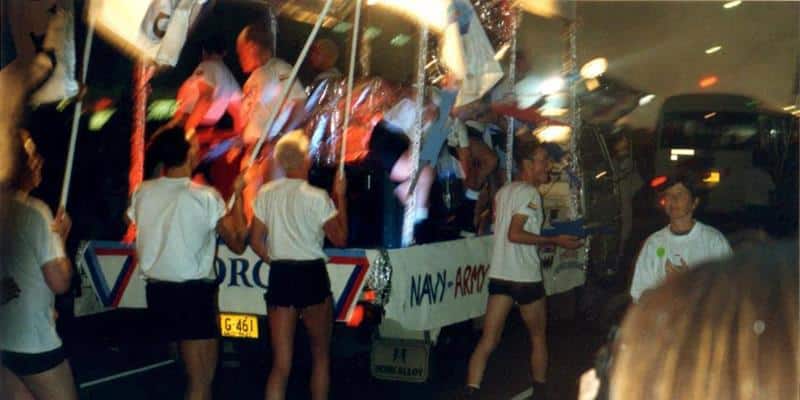G-Force president David Mitchell will lead the DEFGLIS civilian contingent at the 2016 Mardi Gras parade to mark the 20 year anniversary of Defence participation in the Sydney Gay and Lesbian Mardi Gras Parade.
The 1996 G-Force float was the first time that an organisation of serving gay, lesbian and bisexual Defence members participated in the Mardi Gras with approval from Defence.
Planning and approval for this float was not so straightforward, and the history of this event reveals a determined G-Force leadership facing down opposition within the Defence hierarchy.
In late August 1995, G-Force founder and President David Mitchell wrote to Brigadier Adrian D’Hage, Head of Defence Public Relations, to advise that G-Force intended to march in Mardi Gras in 1996. The letter emphasised:
We [G-Force] are becoming a significant group within the Australian gay community and as such we feel we have the right to express ourselves in celebration of this position. You said when I last spoke to you that you had no problem with this participation and that all you required was confirmation that the Mardi Gras Association and parade were for celebration of the gay community. They are more than this, they are to affirm the pride, joy, dignity and identity of our community and its people.
Mitchell also thought that other gay, lesbian or bisexual Defence members watching the parade would learn about G-Force’s existence as a support service.
Whilst D’Hage had initially supported Mitchell, by November 1995 the Defence position changed. The Vice Chief of Defence Force, Vice-Admiral Robert Walls, prohibited G-Force from participating in Mardi Gras. D’Hage stated to the media:
When we look at the charter of the Gay and Lesbian Mardis [sic] Gras Pty Ltd, it is not only a celebration of their sexuality, it is also a promotion…The difficulty we have with that is that it is very doubtful as to whether an official defence force float is an appropriate vehicle to promote a particular lifestyle. We would make the same decision if they were participating in a heterosexual parade.
Defence argued that this was not discrimination, but recollections of both Mitchell and D’Hage indicate that there was homophobia among some Defence top brass. D’Hage recalled Vice-Admiral Walls saying the float would go ahead “over my dead body.”
Mitchell recollected hanging up on a senior officer who rang to tell him that if he went ahead with the march “I will ruin you.”
What Mitchell and D’Hage understood was that the Defence could not legally stop G-Force members from marching in the parade so long as they did not do so in uniform. D’Hage indicates that he spent the next month working behind the scenes then Chief of Defence Force, General John Baker.
In January 1996 the press reported that the Defence agreed to support a G-Force float in the Mardi Gras providing it was “non-military” looking.
D’Hage said that he feared visions of a “huge pink cardboard bloody tank with a condom over the barrel and a bloody great slouch hat over the turret.”
The RSL condemned the ADF’s decision, then National President, Major General Digger James, said “I see it really as Defence Force bosses proselytising on behalf of a sectional group.”
G-Force rallied around twenty people to march, including both serving Defence personnel and their partners. The top of the float read: “G-Force Gay and Lesbian Defence Force Members and Friends: Celebrating Community Serving Our Country”. Mitchell was overjoyed to be able to use the expression “out and proud” in front of the world’s media and Australian public.
“Gay and lesbian people want to serve and serve our country the same as straight people, the same as people from different other walks of life,” said Mitchell.
G-Force did not march again in Mardi Gras, primarily due to the logistical and financial challenges of organising a float.
Although G-Force was the first group of serving ADF personnel to march in the Sydney Gay and Lesbian Mardi Gras with the approval of Defence, there have been number of other Defence floats in the Mardi Gras prior to DEFGLIS taking over responsibility to organise floats each year since 2008.
In 1993 a group of straight ex-servicemen organised an effigy of Victorian RSL President Bruce Ruxton as the group ‘Veterans Against Discrimination’ and in 1999 a small group of servicemen marched under a banner ‘Defence in Unity’.
In 2013 the ADF and DEFGLIS made history marching in uniform for the first time.
As Mardi Gras continues to represent Australia’s largest iconic cultural festival that celebrates LGBTI community pride, the Defence community will continue to, as Mitchell foresaw in 1996, be “out and proud”.
Mitchell will lead the DEFGLIS civilian contingent in the 2016 Mardi Gras parade alongside contemporaries who marched 20 years ago.
Associate Professor Riseman is a lead researcher with the Australian Catholic University and is a lead for the research project “Serving in Silence? Australian LGBTI military service since 1945” that is being conduct in conjunction with the DEFGLIS reflections project.
If you identify as LGBTI and served in the Australian Defence Force after World War II, we seek your participation in our research. To contact Riseman and the research team, please write to: research@defglis.com.au
